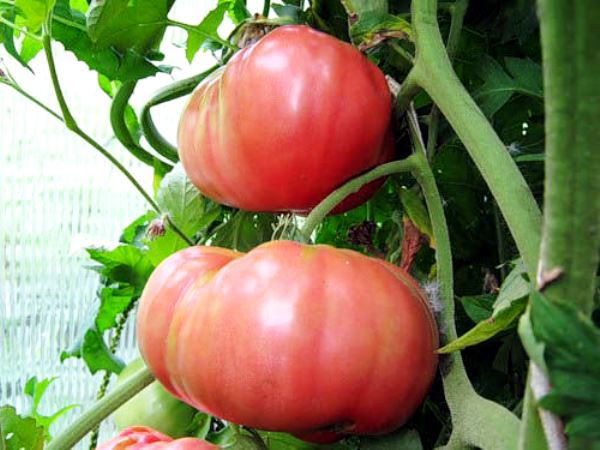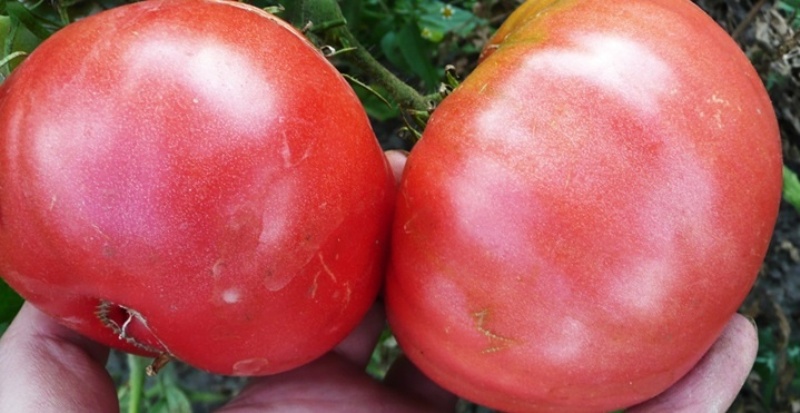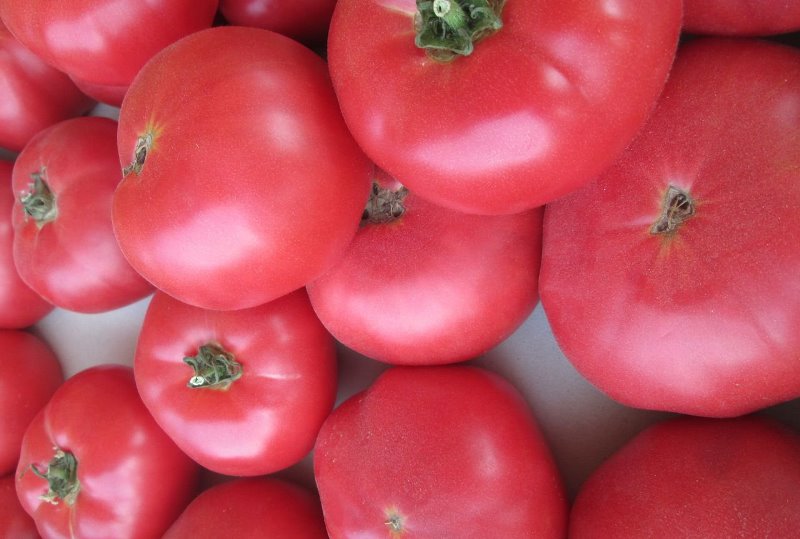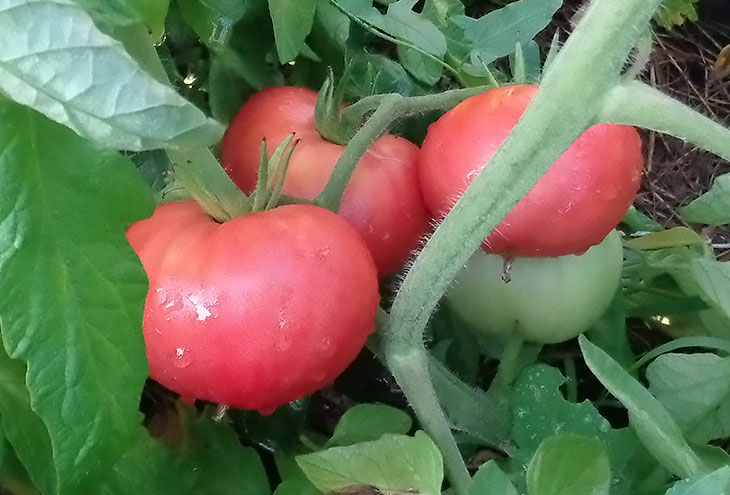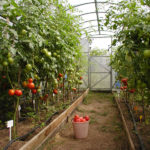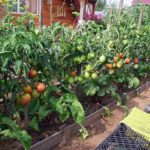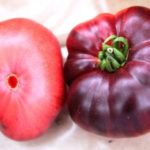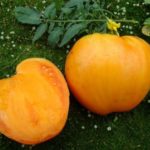There are many hybrid varieties, of which the Raspberry Giant tomato is the most in demand. The description of the variety is amazing: the tomato has captivated gardeners with its large fruit weight and excellent taste characteristics.
general information
The Raspberry tomato is determinate, does not require growth regulation, and therefore does not require pinching of growth points.
The main features of the variety are:
- bush type - not standard;
- strong stem and root;
- height - not less than 0.7 m;
- number of brushes – 10 – 12;
- leaf color - dark green;
- the fruits retain their integrity and do not crack;
- the stalk has an articulation;
- holds large fruits well;
- a small amount of seeds.
The tomato variety is immune to diseases and does not have time to contract late blight, since fruit ripening begins three months after planting the seedlings. At this time, the weather is stable, temperature changes have not yet begun.
The variety grows well both in the garden and in greenhouses. Productivity is up to 6 kilograms per bush and up to 18 kilograms per 1 sq. m.
Features of the variety
The Raspberry Giant tomato has a flattened shape, medium or low ribbing. The fruits remain marketable for a long time, all have approximately the same size.
The weight of tomatoes of the described variety reaches 400 grams, diameter - 10 centimeters. Among all the tomato varieties, the Raspberry Giant is one of the largest. The thin, dense skin shines and remains smooth for a long time. Unripe tomatoes are soft green, ripe ones are pink or crimson.
The tomato pulp is juicy, fleshy, and has medium density. The small number of seeds, the size of which is very small, is surprising. The dry matter content in fruits is below average.
The crop can be stored for quite a long time. To do this, you need to choose a dry, dark place at room temperature. Changes are extremely undesirable, because the taste of the tomatoes deteriorates. The Raspberry Giant tomato tolerates transportation well, including over long distances.
The Raspberry Giant tomato has a sweet taste with a slight sourness; children, allergy sufferers, and people on a diet love the vegetable. It can be consumed fresh, frozen, stewed, or added to salads and other dishes.
Canned tomatoes of this variety are not very popular due to their rather large size, but when crushed they are perfect for use in various preparations: paste, juice, ketchup and various sauces. The characteristics and description of the variety are fully confirmed by the obtained cultivation results.
Advantages and disadvantages of the variety
Like all tomatoes, the Raspberry Giant has a number of advantages and disadvantages. Obvious advantages:
- early ripeness;
- large fruit size;
- preservation of presentation;
- excellent harvest;
- resistance to diseases and pests.
Every gardener who has planted and cultivated the Raspberry Giant notes that most of the beneficial properties and high taste are preserved during heat treatment, giving the most positive reviews about the variety.
The only fact that in a certain way can play the role of a disadvantage and spoil the description of a tomato is the impossibility of using this tomato in canning in its entirety. Isolated cases of disease may occur, but this is a fairly rare occurrence. In general, the Raspberry Giant is characterized extremely positively and has many excellent reviews from gardeners.
Features of planting and growing
The Sedek Raspberry Giant tomato variety was bred specifically for cultivation in a greenhouse, but if a warm, dry climate prevails in a particular region, then cultivation in an open area is possible. Seeds for seedlings are sown after March 10. Before this moment, the seeds should be checked for germination by dipping them in a glass of water for 20 minutes. The well-preserved seeds sink to the bottom of the glass, the rest float to the surface. To increase the germination rate of seeds, they are treated with a growth stimulator.
Sowing is carried out exclusively in nutritious soil, which is a mixture of earth, peat and sand in equal proportions. To achieve the desired pH level, you need to add ash to the soil. If necessary, ready-made soil can be purchased at a farm store or hypermarket.
Peat pots should be used as a container for seedlings. This is the most preferred option. If other containers are used, drainage holes must be made at the bottom.
After filling the container with soil, it should be slightly moistened, and then the seeds should be placed on the surface. The distance between them is at least 3 centimeters. The material should be sprinkled with a layer of soil on top and covered with a vapor barrier, light-transmitting material. After 5–6 days of being in a warm and bright place, the first sprouts will appear.
After germination of the seeds, the boxes should be opened and placed in a place that does not lack sunlight. The optimal air temperature is from 22 °C to 25 °C. If there is not enough light, then it is necessary to organize lighting. Drafts are not allowed.
In the process of growing tomatoes, before planting in open ground, the plants should be fertilized. This is the key to gaining green mass and building immunity.
When two or three true leaves appear on the plant, you should think about picking. When the plants reach the age of two months, the seedlings are transferred to a greenhouse, the soil in which has been dug up in advance and well moistened.
Throughout the entire growing period, the Crimson Giant bushes form and take steps. The lower leaves are torn off to prevent the appearance of pests and the onset of putrefactive processes.In the middle zone, with two formed stems, you can grow an excellent harvest of tomatoes of this variety; the first few bunches even have time to fully ripen on the bush.
At the initial stages of development, immediately after planting in the ground, plants should be fertilized with nitrogenous fertilizers, which will help the plant grow a strong mass of leaves and form strong branches. When flowers appear, you should switch from fertilizers containing nitrogen to phosphorus additives and formulations containing potassium.
Features of caring for the variety
Caring for the Crimson Giant is not difficult, but it is necessary to maintain periodicity. Care is as follows:
- proper staking of plants;
- watering according to the most optimal scheme;
- high-quality feeding.
Despite the fact that tomatoes of this variety do not grow very tall, they still need a garter. The installation of stakes should occur simultaneously with planting the seedlings to prevent damage to the root system later. At the moment when the stem of the plant begins to sag, it should be tied up.
A week after planting the seedlings, it is necessary to fertilize. A great way to fertilize tomatoes is to use last year's leaves, which are sprinkled on the ground around the plants. After some time, the foliage will rot and the root system will receive the necessary nutrients. It is possible to fertilize using manure.
Watering tomatoes should be done as the soil dries. If the soil is very dry, you should consider moistening it. In this case, watering must be done abundantly.
I have been growing the Raspberry Giant variety for a long time.This can be done most successfully in the southern regions of the Russian Federation, however, subject to greenhouse cultivation, an excellent harvest can be obtained throughout the entire territory of Russia.

